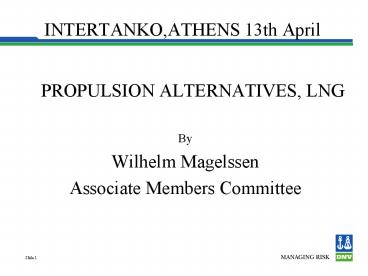INTERTANKO,ATHENS 13th April - PowerPoint PPT Presentation
1 / 29
Title:
INTERTANKO,ATHENS 13th April
Description:
Title: No Slide Title Author: ROED Last modified by: Sally Woulfe Created Date: 2/26/2002 7:10:54 PM Document presentation format: On-screen Show Company – PowerPoint PPT presentation
Number of Views:128
Avg rating:3.0/5.0
Title: INTERTANKO,ATHENS 13th April
1
INTERTANKO,ATHENS 13th April
- PROPULSION ALTERNATIVES, LNG
- By
- Wilhelm Magelssen
- Associate Members Committee
2
Propulsion power for LNG carriers
Engine Power (kW)
21 knots
40,000
20 knots
19 knots
30,000
20,000
Size (m3)
125,000
150,000
175,000
200,000
Source MAN BW
3
Thermal efficiencies
Source MAN BW
4
Handling of boil-off gas
- Use as fuel in boilers
- Accumulation during voyage
- Use as fuel in gas engines
- Use as fuel in gas turbines
- Re-liquefaction
- Burn in oxidizer (incinerator)
5
Means for disposal of boil-off gas
- Steam turbine propulsion
- Two boilers main and auxiliary condenser
- Gas engine propulsion
- One oxidizer with redundant auxiliaries
- Diesel engine propulsion
- One re-liquefaction unit one oxidizer
- Gas turbine propulsion
- One oxidizer with redundant auxiliaries
6
Propulsion alternatives for LNG carriers
- Steam turbine/dual fuel steam boilers
- Dual fuel high pressure gas/diesel engine
- Dual mode low pressure gas/diesel engines
- Low pressure gas engines and diesel engines
- Gas turbine combined gas turbines/diesel
engines - Diesel engine/boil-off re-liquefaction
7
Steam Turbine Propulsion - Simplified
Economiser
Flue gas uptake
Super-heater
Downcomers
Deareator
Furnace
Boiler casing
Water wall
Red gear
H.P
Shaft
Feed pumps
L.P
Main Condenser
Condensate pumps
8
DNV Rules for gas fuelled engine installations
- The Rules define two concepts for safety against
gas hazards in machinery spaces - Inherently gas safe machinery space
- The two-barrier concept as known from the IGC
Code with an additional requirement for fitting
excess flow shut-off in the gas supply - ESD protected machinery space
- Single wall gas piping accepted. Applicable for
low pressure gas engines only
9
Gas engines - piping
- Low pressure gas engines have gas supply piping
which is difficult to arrange with complete
jacketing - There are no low pressure gas engines on the
market at present having fully jacketed gas
piping. However,Wärtsilä, is claiming that they
are in the position in the near future
10
ESD Rule conditions (Emergency Shut Down)
- Conditions for acceptance of ESD protected
machinery space - Gas supply pressure to be lt 10 bar
- Automatic de-energising of all sources of
ignition on detecting of low concentration of gas
and shut-off of gas supply to the engine room - Automatic shut-off of gas supply on loss of
engine room ventilation, detection of fire or
excess gas flow
11
ESD protected engine rooms
- Because of the shut-down requirement for anESD
Protected engine room, the power generation for
propulsion and manoeuvring must be divided
between two or more engine rooms independent of
each other
12
Dual Mode Gas/Diesel Engines
13
ESD protected engine rooms
14
Diesel engines Re-liquefaction
15
Re-liquefaction plant for LNG boil-off
- At present there is experiences only from one
shipboard LNG re-liquefaction plant (NYK) - Power consumption is high (3,5-5,0 MW)
- For LNG cargo tanks with permitted filling ratio
of 99.5 (spherical) overfill protection
arrangements should be considered
16
LNG carrier with oxidizer
17
Coastal LNG carrier Pioneer Knutsen
- delivered 2004, 1100 m3 cargo carrying
capacity - 2 x engines for gas fuel only 2 diesel
engines , - diesel electric propulsion - 2 pods for main propulsion
- redundant propulsion
18
Gas Turbines
- Rolls Royce MT30
- 36 MW flat rated _at_26?C
- 42 thermal efficiency
- 201 g/kWhr on gas
- Dual fuel capable
19
Steam Turbine Propulsion Engine Room Arrt
Cargo Tank
20
Gas Engines/Electric Propulsion Engine Room
Arrt
Cargo Tank
Reduced length
21
General Arrangement Gas Turbines
22
Gas emissions from LNG carriers
Fuel NOx SOx CO2
Steam turbine HFO LNG 200 2.400 180.000
Low speed diesel re-liquefaction HFO 3.950 1.800 120.000
Dual fuel electric LNG only 240 0 100.000
Gas turbines and COGES LNG only 850 0 108.000
Source ALSTOM
Emissions Tonnes / year / ship
23
Economics of LNG Re-liquefaction andSlow Speed
Diesel Propulsion
- Low Fuel Consumption for Propulsion, but power
required by the re-liquefaction plant adds
another 10 20 tons of heavy fuel oil - Unknown Initial Cost for the Re-liquefaction
Plant, but Assumed to be Significant - High Power Requirements for Re-liquefaction, in
the order of 3-5 MW at max. load
24
Economics of Dual Fuel Gas/Diesel Engines/Gas
Turbines and Electric propulsion
- Electric Propulsion Plants Require Higher Initial
Costs - Gas/Diesel Engine Plants Have Lower Fuel
Consumption - Thermal Efficiency 42-44 v.s.
31-33 for Steam Propulsion - Gas/Diesel Engines Have Higher Maintenance Costs
- Fuel Cost Savings for Gas/Diesel Plants Increase
With Higher Fuel Oil Price
25
LNG carrier propulsion - Conclusion
- The traditional steam turbine propulsion has
served LNG carriers well for over 30 years - Future operating modes will require flexibility
and efficient propulsion plants able to
accommodate different ship speeds - Operating economy and environmental issues have
to be considered carefully when selecting
propulsion power plant - Safety and redundancy are important features
required from the propulsion power plant
26
Offshore re-gasification and discharge
27
Experienced personnel, - a serious challenge !
.. insufficient supply of competent people may
have a knock-on effect on other shipping sectors ?
28
LNG Trade in cold Climate
- Cold climate Is this the future environment for
LNG carriers? What kind of impact will this have
on the Propulsion system?
29
End of Presentation
Thank you!

